
The bigeye trevally, also known as the bigeye jack, great trevally, six-banded trevally and dusky jack, is a species of widespread large marine fish classified in the jack family Carangidae. The bigeye trevally is distributed throughout the tropical waters of the Indian and Pacific Oceans, ranging from South Africa in the west to California and Ecuador in the east, including Australia to the south and Japan in the north. The bigeye trevally is best distinguished by its colouration, having a dark second dorsal fin with a white tip on the lobe, and also possessing a small dark spot on the operculum. Other more detailed anatomical features also set the species apart from other members of Caranx. The species is known to grow to a length of 120 cm and 18 kg.
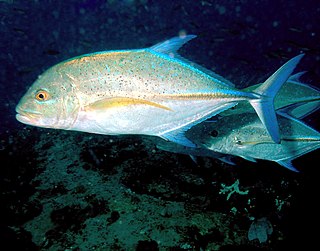
The bluefin trevally, also known as the bluefin jack, bluefin kingfish, bluefinned crevalle, blue ulua, omilu, and spotted trevally, is a species of large, widely distributed marine fish classified in the jack family, Carangidae. The bluefin trevally is distributed throughout the tropical waters of the Indian and Pacific Oceans, ranging from Eastern Africa in the west to Central America in the east, including Japan in the north and Australia in the south. The species grows to a maximum known length of 117 centimetres (46 in) and a weight of 43.5 kilograms (96 lb), however is rare above 80 centimetres (31 in). Bluefin trevally are easily recognised by their electric blue fins, tapered snout and numerous blue and black spots on their sides. Juveniles lack these obvious colours, and must be identified by more detailed anatomical features such as fin ray and scute counts. The bluefin trevally inhabits both inshore environments such as bays, lagoons and shallow reefs, as well as deeper offshore reefs, atolls and bomboras. Juveniles prefer shallower, protected waters, even entering estuaries for short periods in some locations.
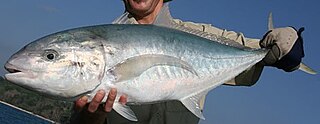
The bludger, also known as the bludger trevally, nakedbreast trevally or Bleeker's jackfish, is a widespread species of large marine fish in the jack family, Carangidae. The bludger inhabits the tropical and subtropical regions of the Indo-west Pacific Ocean, distributed from South Africa in the west to Japan and New Caledonia in the east. It is a large fish, growing to a maximum recorded length of 90 cm, and is very similar to the yellowspotted trevally, Carangoides fulvoguttatus, but can be separated by the complete absence of breast scales and a number of other anatomical features. The species inhabits moderately deep offshore coral and rocky reefs, where it preys on small crustaceans and fish. The reproductive biology of the species is poorly known, but it appears to move to more tropical waters to spawn. The bludger is of intermediate importance to fisheries throughout its range, taken by hook and line and various netting methods. It is of some value to anglers also, considered a good gamefish, but generally regarded as poor eating due to its soft oily flesh, which is used as bait by many anglers. The name ‘bludger’ is said to either refer to the blunt head of the species, or the destination of the fish when caught by professional fishermen who treat the fish as discard.
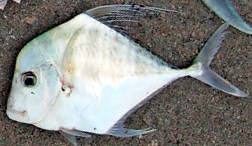
The Indian threadfish, also known as the Indian threadfin, diamond trevally, mirror fish or plumed trevally, is a large species of coastal marine fish of the jack family, Carangidae. The species is widespread in the waters of the tropical Indo-West Pacific Ocean, ranging from east Africa to India, Asia, Indonesia and Australia. Adult fish tend to inhabit coastal waters over reefs down to 100 m in depth, while juveniles inhabit a variety of environments including estuaries and seagrass beds. The Indian threadfish is similar to the other two species in the genus Alectis, with a slight concavity in the profile of the head the most obvious distinguishing feature. It is a large species, growing to 165 cm and 25 kg in weight. The species is carnivorous, consuming fishes, cephalopods and crustaceans. The Indian threadfish is of minor commercial importance, and has been the subject of aquaculture in Singapore.
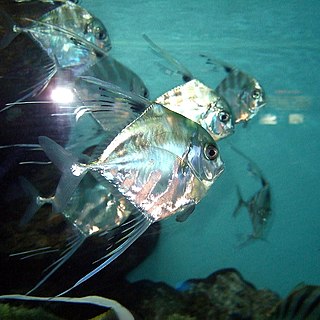
Alectis is a genus of fish in the family Carangidae containing three extant species, all of which are large marine fishes. They are commonly known as threadfish, diamond trevallies or pompanos, although they have no close affiliation with the true pompano genus.

The African threadfish, also known as the Alexandria pompano, is a species of large marine fish in the jack family, Carangidae. The species is distributed along the coast of tropical Africa in the eastern Atlantic Ocean, extending to the Mediterranean Sea. Adults live predominantly in waters shallower than 70 m deep, often forming small schools. The African threadfish is similar in appearance to the closely related and co-occurring African pompano, with the species' most definitive feature its slightly concave head profile. Like other members of the genus Alectis, the juveniles of the species have long trailing dorsal and anal fins. The African threadfish is of minor commercial importance, and is also considered to be a game fish.

The Malabar trevally, also known as the Malabar jack, Malabar kingfish or nakedshield kingfish, is a species of large inshore marine fish of the jack family, Carangidae. It is distributed throughout the Indian and west Pacific Oceans from South Africa in the west to Japan and Australia in the east, inhabiting reefs and sandy bays on the continental shelf. The Malabar trevally is similar to many of the other species in the genus Carangoides, with the number of gill rakers and the grey-brown colour of the tongue being the diagnostic features. The Malabar trevally is a predator, taking a variety of small fish, cephalopods and crustaceans. The species is of minor economic importance throughout its range, caught by a variety of net and handline methods.

The cleftbelly trevally, also known as the cleftbelly kingfish, Kuweh trevally or thin crevalle, is a species of tropical marine fish of the jack family, Carangidae. The species inhabits coastal waters throughout the Indo-West Pacific region from South Africa in the west to Japan in the east, often found near the water's surface. The cleftbelly trevally is the only member of the genus Atropus and is distinguished by a number of anatomical characteristics, with a deep median groove in the belly giving the species its common name. It is not a large fish, growing to a maximum recorded length of 26.5 cm. Cleftbelly trevally are predatory fish, taking a variety of small crustaceans and fish. The species is of minor importance to fisheries throughout its range.

The longfin trevally, also known as the longfin kingfish, longfin cavalla or armed trevally, is a species of inshore marine fish in the jack family, Carangidae. The species is common in tropical to subtropical waters of the Indo-Pacific, ranging from South Africa in the west to Japan in the east, typically inhabiting inshore reefs and bays. The species is easily distinguished by its elongate dorsal and anal fin lobes and filamentous dorsal rays, as well as its scaleless breast. Longfin trevally are pelagic predators, taking a variety of small fish, cephalopods and crustaceans, and reach sexual maturity at around 21 cm. The species has a maximum known length of 57 cm and weight of 3.5 kg. The longfin trevally has a very complex taxonomic history which is closely intertwined with another currently valid species, Carangoides ciliarius, which may yet prove to be synonymous. Longfin trevally are of minor importance to fisheries throughout their range and are considered good table fish, and are occasionally taken by anglers.
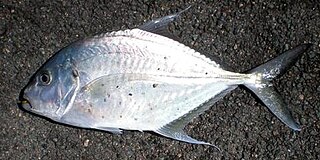
The longnose trevally, also known as the tea-leaf trevally, club-nosed trevally, grunting trevally or dusky trevally, is a species of inshore marine fish in the jack family, Carangidae. The species is distributed throughout the tropical and subtropical waters of the Indian and west Pacific Oceans from South Africa to New Zealand and Japan, inhabiting coastal waters, especially reefs, to a depth of 90 m. The longnose trevally is distinguished from similar species by a combination of a scaleless breast and the number of gill rakers and fin rays. It is a moderately large fish, growing to a maximum known length of 72 cm and 4.35 kg. The longnose trevally is a predatory fish, consuming small fish, crustaceans and molluscs. The species is of minor commercial importance throughout its range, and is considered to be a good table fish.

The coastal trevally, also known as the onion trevally, Japanese trevally or bluefin kingfish, is a species of inshore marine fish in the jack family Carangidae. The species is distributed throughout the tropical and subtropical waters of the Indian and west Pacific Oceans, from South Africa in the west to Japan and New Caledonia in the east, reaching as far south as Australia. The species is found on deep coastal reefs, both in schools and as solitary individuals, where they prey on small midwater organisms including crustaceans, small fish and cephalopods. The species is taken as bycatch in a number of fisheries throughout its range by a number of fishing methods and is of little commercial value, but is considered to be a good table fish. A mistype in the original volume in which Eduard Rüppell named the species led to the combination Carangoides caeruleopinnatus, which has incorrectly spread through the literature.

The threadfin jack or thread pompano is a species of coastal marine fish in the jack family Carangidae. The species inhabits the tropical waters of the eastern Pacific Ocean from Baja California in the north to Ecuador and the Galapagos Islands in the south. It is a moderately large fish, growing to 60 cm (24 in) and may be recognized by its filamentous dorsal and anal fin lobes. The threadfin jack inhabits both deeper coastal waters and inshore environments, including reefs and estuaries, where it preys on minute benthic and pelagic organisms, including small fishes and crustaceans. Very little is known about the ecology and reproductive cycle in the species. The threadfin jack is of importance to fisheries throughout its distribution, caught by hook-and-line and net methods and marketed fresh and salted, and is considered a very good table fish. The species was named Carangoides dorsalis by Theodore Gill 20 years before the name Caranx otrynter was introduced, but confusion with Vomer dorsalis led to the proposal of the new name to separate the two species.

Caranx is a genus of tropical to subtropical marine fishes in the jack family Carangidae, commonly known as jacks, trevallies and kingfishes. They are moderate- to large-sized, deep-bodied fishes which are distinguished from other carangid genera by specific gill raker, fin ray and dentition characteristics. The genus is represented in the Pacific, Indian and Atlantic Oceans, inhabiting both inshore and offshore regions, ranging from estuaries and bays to deep reefs and offshore islands. All species are powerful predators, taking a variety of fish, crustaceans and cephalopods, while they in turn are prey to larger pelagic fishes and sharks. A number of fish in the genus have a reputation as powerful gamefish and are highly sought by anglers. They often make up high amounts of the catch in various fisheries, but are generally considered poor to fair table fishes.

The blue trevally, also known as the banded trevally, barred trevally, Ferdau's trevally or Forskaal's jackfish, is a common, widespread species of pelagic marine fish classified in the jack family, Carangidae. The blue trevally is distributed throughout the tropical and subtropical waters of the Indo-Pacific and central Pacific regions, ranging from South Africa in the west to Hawaii in the east. It is a moderately large fish, growing to a recorded maximum length of 70 cm, with the number of rays in the second dorsal fin and the colouring serving as diagnostic features of the species. The species inhabits waters to depths of 60 m, generally inhabiting reefs, beaches, lagoons, and areas with sandy substrates. It is a predatory fish, taking other fish, prawns, crabs, and molluscs, and very little is known of the species' reproductive biology. The blue trevally is of varying importance to fisheries throughout its range, with some regions having high catches of the fish. It is considered to be a gamefish, and is sought after for its excellent eating qualities.

The yellowspotted trevally, also known as the yellowspotted kingfish, goldspotted trevally, tarrum, or yellowspot, is a widespread species of large inshore marine fish in the jack family Carangidae. The yellowspotted trevally inhabits the tropical and subtropical waters of the western Indo-Pacific region, from South Africa in the west to Japan and Australia in the east. The species is known to grow to a maximum length of at least 1.2 m, and is distinguished by gill raker and fin morphology, as well as the distinctive golden spots which give the fish its name. The yellowspotted trevally generally prefers inshore rocky and coral reefs, but is occasionally found over deep offshore sand banks to a depth of 100 m. It is a predatory fish, taking fish, cephalopods, and crustaceans, and shows diet partitioning with other trevallies in studies conducted in Australian waters. Reproduction is poorly studied, although observational evidence suggests spawning occurs in aggregations, probably during summer in South Africa. It is generally of minor importance to commercial fisheries throughout its range, but is considered an excellent sportfish by anglers and spearfishermen, and a good table fish.

The bumpnose trevally, also known as the bumpnose kingfish or onion kingfish, is a species of relatively small inshore marine fish classified in the jack family Carangidae. The bumpnose trevally is fairly common in the tropical and subtropical waters of the Indo-west Pacific region, ranging from South Africa in the west to Japan and Samoa in the east. It is a small species by carangid standards, reaching a maximum known length of 32 cm, and can be distinguished from the similarly shaped Carangoides armatus by a distinct 'bump' on the snout, which gives the fish its common name. The species inhabits coastal waters, often living along bays and beaches, where it takes shrimp, small crabs, and juvenile fish as prey. The bumpnose trevally is of minor importance to fisheries throughout its range, taken by hook and line, trawls, and seine nets. It is also of minor importance to anglers, taken by baits from beaches and piers, and is considered a modest table fish.

The blacktip trevally, also known as the blacktip kingfish or yellowtail kingfish, is a species of large marine fish classified in the jack family Carangidae. The blacktip trevally is distributed throughout the tropical to subtropical Indian and West Pacific Oceans, ranging from South Africa in the west to Fiji, Japan and northern Australia in the east. It inhabits coastal waters throughout its range, preferring moderately deep clear waters over rocky and coral reefs. The blacktip trevally is easily distinguished by its yellow fins and a dark upper caudal fin lobe which gives the species its common name, as well as a host of other anatomical features. The species is known to reach a maximum size of 1 m. It is a benthopelagic predator, commonly forming small shoals where it takes a variety of fishes, cephalopods and crustaceans as prey. Little is known of reproduction in the species, and spawning is assumed to take place in more tropical regions of its range, with juveniles known to inhabit bays and large estuaries. Blacktip trevally are often caught using hook and line and various nets in commercial fisheries although don't make up a large part of the market. They are also popular with anglers due to their fighting ability and decent table qualities.

The brassy trevally, Caranx papuensis is a species of large marine fish classified in the jack family, Carangidae.

The false scad, also known as the spotfin scad, ten-finned horse mackerel and yellow horse mackerel, is a species of medium-sized marine fish classified in the jack family Carangidae. The false scad is distributed throughout the tropical and temperate waters of the eastern Atlantic Ocean from Namibia in the south to Spain and throughout most of the Mediterranean in the north. The species has an atypical body form compared to other species of Caranx, and can be distinguished from these on its elongate 'scad-like' body shape alone. Distinguishing the species from members of Decapterus and Trachurus is more difficult, requiring detailed anatomical analysis. The false scad is known to grow to a length of 60 cm and a weight of 1 kg. The species lives both pelagically and demersally in continental shelf waters, ranging from depths of 15 to 200 m. It is a predatory fish, taking small fishes, crustaceans including euphausiids and shrimps, and cephalopods as its main prey, with significant dietary shifts as it ages. The false scad reaches sexual maturity at 2 years of age, with spawning occurring between April and July in shallow inshore waters, where the juveniles remain. The species is of major importance to fisheries throughout its range, but particularly from Morocco to Senegal, with annual catches ranging from 500 to 19000 t. The species is caught using trawls, seine nets and gill nets and sold fresh, frozen or salted.

The Senegal jack, also known as the African jack, is a species of large marine fish classified in the jack family Carangidae. The species is distributed through the tropical waters of the eastern Atlantic Ocean, ranging along the west African coast from Angola in the south to Mauritania in the north. It can be distinguished from co-occurring relatives by its longer dorsal fin lobe, as well as a host of other anatomical features. The Senegal jack grows to a known maximum length of 1 m. It is a coastal species, known to live semi-pelagically, inhabiting both the sea floor and surface waters to depths of around 200 m. The Senegal jack is a predatory species, taking fish, crabs and shrimps as its main prey items. The species reaches sexual maturity at 21 cm in females and 24 cm in males, with spawning occurring in two periods; February to April and September to November. The species is of minor importance to fisheries, and is not discriminated from other jacks in catch statistics. It is taken by trawls, seines and hook and line, and sold fresh or preserved.



























